Chinchorro Crocodile Encounters by Don Silcock
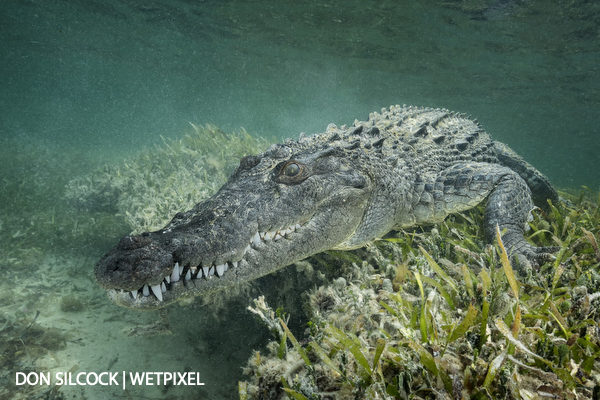
Chinchorro Crocodile Encounters by Don Silcock
The pursuit of unusual and compelling photo-opportunities has led me on some interesting journeys over the last few years. But few come close to the raw excitement of photographing the American Crocodiles of Mexico’s Banco Chinchorro!
American Crocodiles
The American Crocodile (Crocodylus acutus) is considered as a relatively large species. With males reaching maximum lengths of 5 to 6 m when fully mature while females are generally smaller at around 3 to 3.5 m.

Like all reptiles they are cold-blooded and breath air. So they are most comfortable in warm shallow waters. And the extensive mangroves of Cayo Centro at Banco Chinchorro offer an almost perfect environment for them.
The American Crocodile is a cousin of the Australian apex reptilian predator; the hyper-dangerous salt-water crocodile. Unlike its antipodean relative, they are not considered to be aggressive towards humans. And only a few (unverified) cases of fatal attacks have ever been reported As its common name suggests, American crocodiles can be found all the way from the Everglades on the southern tip of Florida through the Caribbean and Central America and on down into the northern end of South America in the countries of Ecuador, Columbia and Venezuela.
The largest known population inhabits the land-locked hyper-saline Lake Enriquillo in the Dominican Republic, but by far the best place for reliable and up-close underwater encounters with the American crocodile is Banco Chinchorro, in the south-east of Mexico, near the border with Belize.

Banco Chinchorro Biosphere
Although hardly a household name… Banco Chinchorro is, in fact, one of the largest coral atolls in the Northern hemisphere and a UNESCO Biosphere Reserve.
It covers an area of almost 800 km²… and is located some 35 km offshore. The reefs of Banco Chinchorro are very healthy and a real joy to dive.
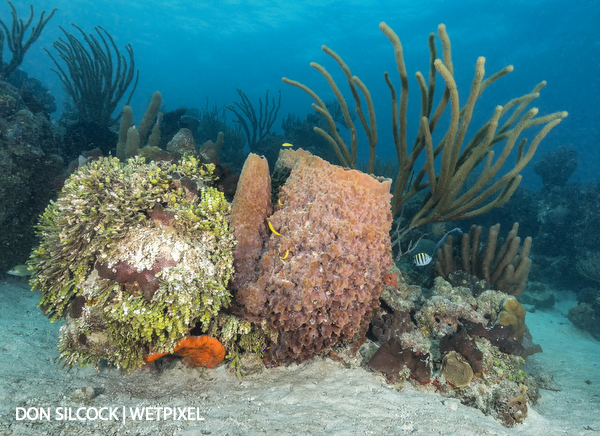
But if it’s the crocodiles you’re after, Cayo Centro is where you need to be! Although only just under six km² in size Cayo Centro is the largest of the three islands on the atoll and is home to an estimated permanent population of between 300 to 500 American Crocodiles.
It also hosts a small seasonal population of local fishermen. They have built a scattering of about ten huts on stilts, called palafitos, above the shallow waters of the lagoon on the East shore of the island along with a similar number onshore called cabañas.
How and when the crocodiles took up residence is not clear, but the dense mangroves of Cayo Centro offer a perfect habitat for them. The rich waters around the island provide plenty of sustenance!
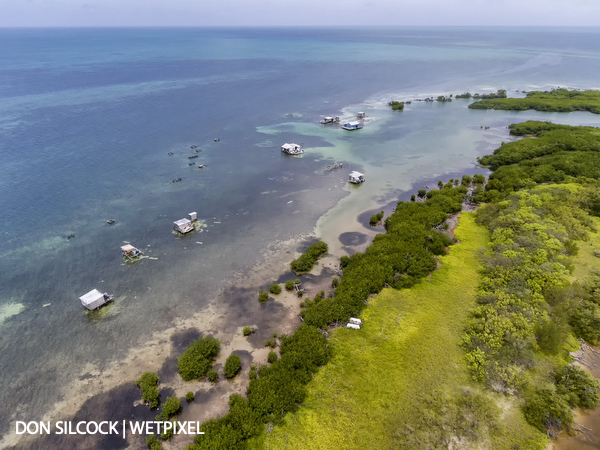
The crocodiles and the fishermen have an almost symbiotic relationship, tolerating each other’s presence in this remote location. The main trigger for interactions is the noise of the chopping tables. The fishermen fillet their catches on tables above the lagoon at the palafitos, and at the water’s edge at the cabañas. Hence, the crocodiles will immediately gather when they hear the knives on the chopping boards.
For the crocodiles, it’s snack time, while for the fishermen it is automated waste disposal
How it Works…
In-water encounters with the American Crocodiles of Banco Chinchorro are done on snorkel. As it is too shallow for scuba near the palafitos, plus it’s easier to maneuver when unencumbered.
Positioning and visibility are the keys to safe encounters. And our palafito had some prime real estate just in front of its main porch in the form of a large sandy patch, that stretches out to the left of the hut.
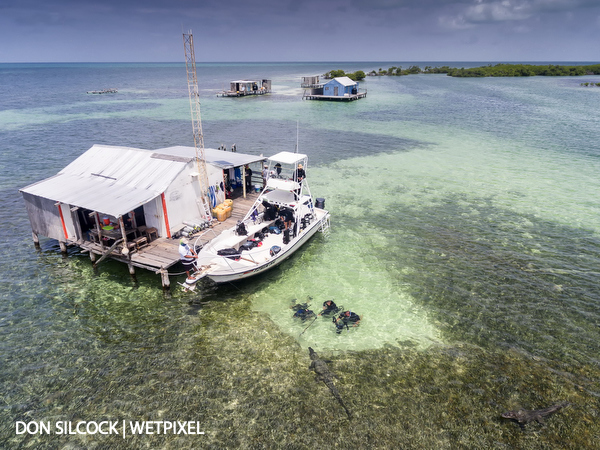
Most of the lagoon has a rich coating of seagrass on the bottom, which allows the crocodiles to blend in perfectly when they submerge. This makes them hard to spot from the surface. The sandy patch makes it very easy to see who/what is there, so the basic concept is to keep the humans on the sandy patch and the crocodiles on the seagrass…
Mooring the boat moored alongside the palafito ensures that one direction is blocked. The sandy patch means that any crocodiles sneaking in can be spotted, and by feeding them from the front of the boat the “encounter zone” is quite well defined and controllable!
The actual control in the water is done with a wooden stick, albeit a large one… but a stick nonetheless. It is used by the wrangler to warn and calm the crocodile when it gets excited or aggressive. As well as a vertical barrier if it advances on to the sand. Despite my initial doubts on its usefulness, it turned out to be remarkably effective!
Eyeball to Eyeball
Of course, all those eminently sensible logistics were far from mind when the time came to get in the water for the first encounter, and I was very nervous as I descended the ladder at the back of the boat that first time.
Then, suddenly, in front of you is a serious looking piece of reptilian hardware that is watching you as intently as you are watching it. Inscrutable is the word that comes to mind…
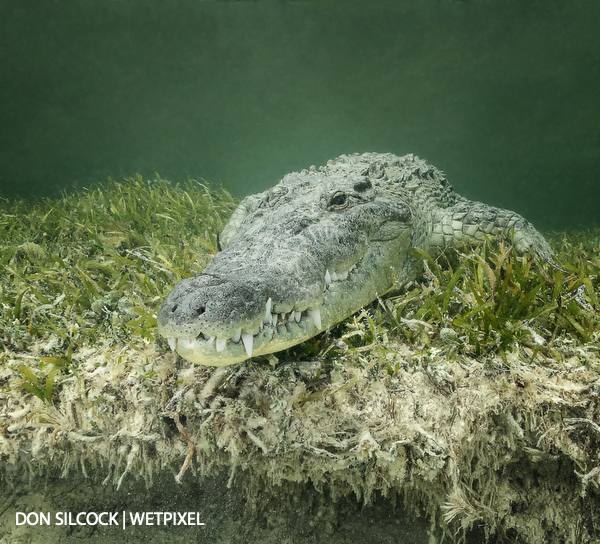
Underwater encounters with big animals are rarely if ever static — they move, often constantly and occasionally very fast. Whereas the American Crocodiles of Banco Chinchorro remain completely still. But with coiled-up energy that is unleashed when they attack.
The problem is that there is virtually no way of knowing when they will attack. So there is intense tension as you maneuver closer to get good images. Knowing that could that trigger the crocodile to attack. So you are very reliant on that wooden stick and the reaction time of the crocodile wrangler.
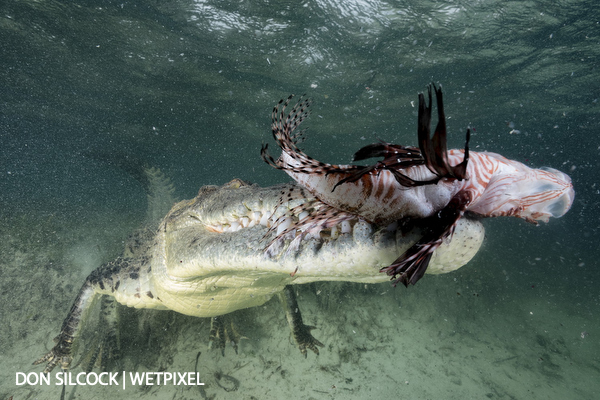
Is it Dangerous?
Probably and possibly are the best descriptors… As there is no doubt that they could inflict serious harm, but nobody has been attacked!
Is it special? Yes, for sure it is, being so close to such large and potentially dangerous reptiles is something else. Plus, the whole experience of staying in the fisherman’s palafito hut with no running water and just a small generator for power is very different!
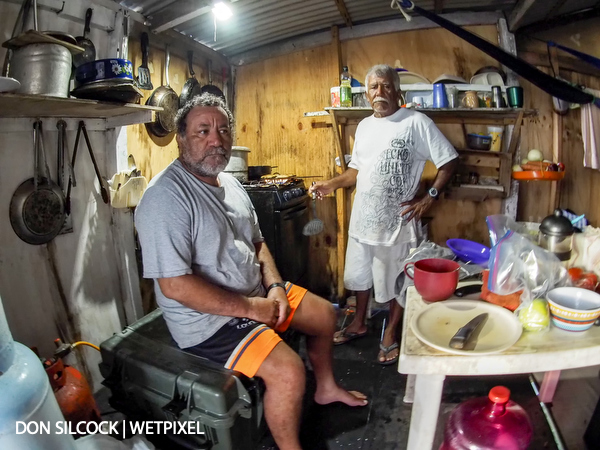
The wranglers say that the young Chinchorro crocodiles are by far the most dangerous — because they are unpredictable… The big crocodiles may look fierce and very threatening. But they are not particularly aggressive and tend to be much calmer than the young ones.
The wrangler’s golden rule is to not to take their eyes off the crocodiles and to allow them space. At the same time, do not allow them to command that space by using the large wooden stick as a vertical barrier between them and the guests.
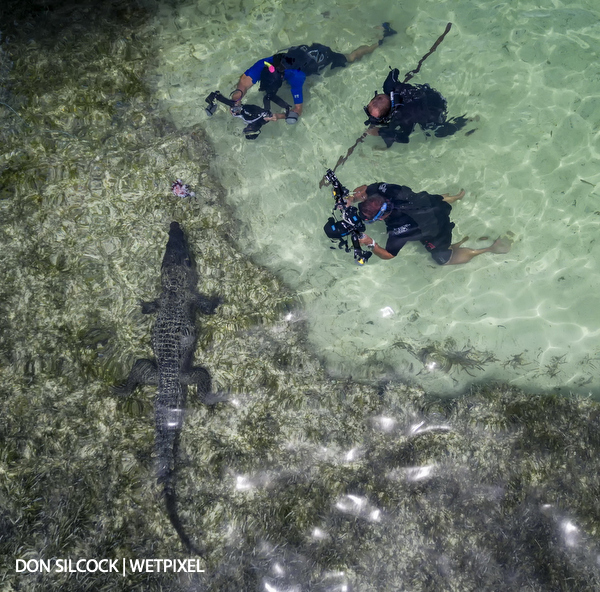
Don Silcock
Don is an Australian underwater photographer and photojournalist based from Bali in Indonesia. His website has extensive location guides, articles and images on some of the world’s best diving locations and underwater experiences.